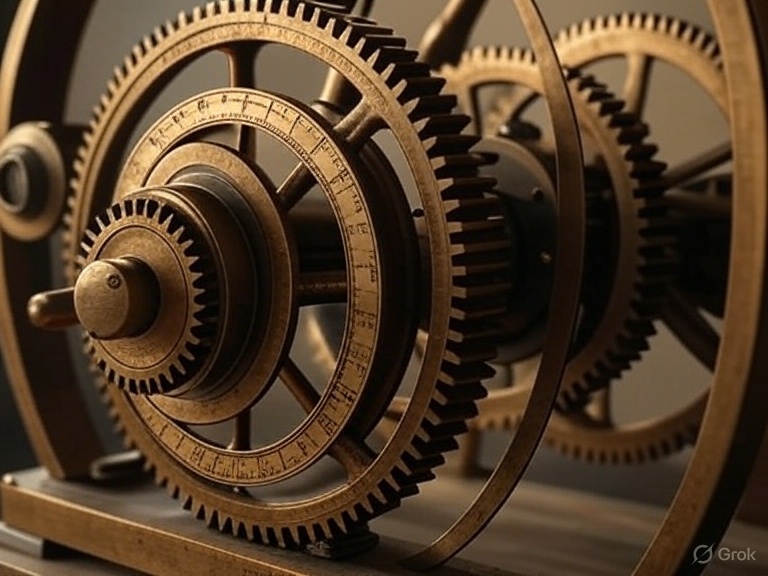In 1901, divers off the coast of the Greek island Antikythera discovered an ancient shipwreck. Among the treasures was a corroded, bronze device that would later astound historians, scientists, and engineers: the Antikythera mechanism. Dating back to around 100 BCE, this intricate assembly of gears and dials has led experts to describe it as the world’s first analog computer — a device capable of predicting astronomical events centuries in advance.
But what exactly was the Antikythera mechanism? How did an ancient civilization create something so advanced, and what does it reveal about lost knowledge in the ancient world?
Discovery and Initial Examination
The device was recovered along with statues, pottery, and other artifacts from a Roman cargo ship. Early examination showed a compact, bronze object filled with interlocking gears, roughly the size of a shoebox.
At first, scholars struggled to understand its purpose. It appeared too sophisticated for its time, and many assumed it was a modern forgery. It wasn’t until the 1950s and 1970s, with the advent of X-ray imaging, that scientists began to decode the mechanism’s inner workings.
How the Mechanism Worked
The Antikythera mechanism is a geared astronomical calculator. It could predict:
- Lunar cycles – including phases of the Moon and eclipses.
- Solar cycles – tracking the Sun’s apparent movement across the zodiac.
- Planetary positions – some researchers believe it could model Mercury, Venus, Mars, Jupiter, and Saturn.
- Olympic cycles – indicating the timing of the ancient Greek games.
The device consisted of at least 30 bronze gears, meticulously designed to work together. Each turn of the hand-crank on the side would advance the gears, aligning the dials to display complex celestial events with remarkable accuracy.

Why It’s Called the First Computer
Although not electronic, the Antikythera mechanism shares essential qualities with modern computers:
- Input and Output: Users could rotate a crank (input) to view future celestial positions on dials (output).
- Programmable Calculations: The gears encoded precise astronomical calculations, effectively performing pre-programmed computations.
- Complexity: The intricate arrangement of gears represents mechanical logic, equivalent to basic computational operations.
In short, the Antikythera mechanism represents human ingenuity in engineering and abstract thinking, centuries ahead of its time.
Modern Science Sheds Light on the Mechanism
Recent studies using 3D X-ray tomography and computer simulations have revealed astonishing details:
- The gears were triangular-toothed and crafted to precise specifications.
- Inscriptions on the device provide a user manual, detailing how to operate it for predicting eclipses, zodiac positions, and other astronomical events.
- Some dials used a Metonic calendar system, correlating 19 solar years with 235 lunar months, a sophisticated understanding of celestial cycles.
These findings demonstrate that ancient Greek scientists possessed advanced knowledge of astronomy, mathematics, and engineering far beyond what historians previously assumed.
The Mystery of Its Origins
Despite extensive research, several questions remain:
- Who designed the mechanism? Some suggest Hipparchus, the Greek astronomer, may have inspired its design.
- How widely were such devices used? The Antikythera mechanism may have been one of many, but others were lost to history.
- How did such advanced knowledge disappear? Wars, natural disasters, and the gradual decline of Greek and Roman technology may have led to the loss of these mechanical marvels.
The mechanism challenges the notion that technological progress is linear, showing that ancient civilizations achieved remarkable sophistication long before the Middle Ages.

Why the Antikythera Mechanism Matters Today
- Understanding Ancient Knowledge: It forces historians to reconsider how much the ancient Greeks knew about astronomy and mechanics.
- Engineering Inspiration: Modern engineers study its design for insights into precision gearwork and mechanical computation.
- Challenging Historical Assumptions: The device reminds us that complex technology existed long before electronics, and that knowledge can be lost across centuries.
The mechanism serves as a bridge between science, history, and human curiosity, showing that the pursuit of knowledge is timeless.
Comparisons to Modern Technology
While the mechanism is mechanical, its purpose aligns with contemporary computational goals:
- Predicting events based on mathematical models.
- Encoding data in a tangible, mechanical form.
- Allowing multiple simultaneous calculations — in this case, lunar, solar, and planetary cycles.
It’s a reminder that the concept of computing is older than electricity or silicon chips. The Antikythera mechanism essentially laid the philosophical groundwork for later inventions in computing.
Conclusion: A Testament to Human Ingenuity
The Antikythera mechanism is more than a historical curiosity — it is a testament to the brilliance of ancient civilizations. By combining mathematics, astronomy, and precision engineering, the Greeks created a device that functioned as a computer long before the modern era.
Its discovery highlights the possibility that lost technologies and forgotten knowledge may exist in other corners of history. As researchers continue to study the mechanism, it serves as a reminder that human curiosity and ingenuity are timeless, capable of achieving wonders we are still uncovering today.
For historians, scientists, and technology enthusiasts alike, the Antikythera mechanism is proof that the roots of modern science stretch back over two millennia, inspiring us to reimagine what ancient civilizations were truly capable of.

